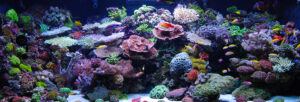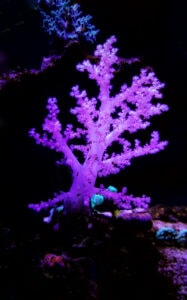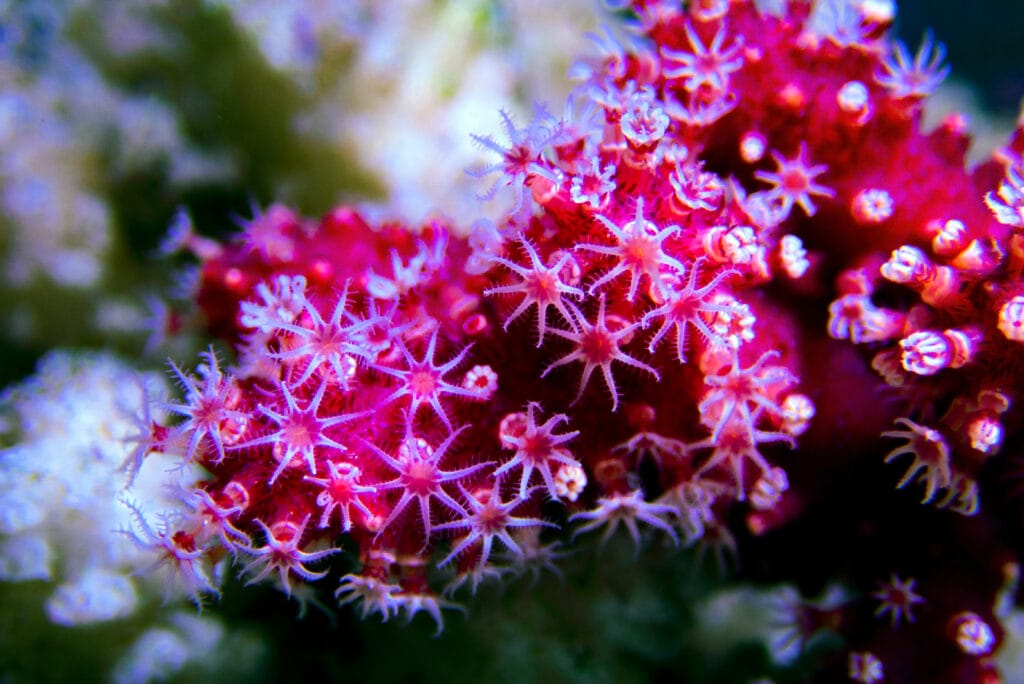We’ve come a long, long way in advancing natural marine aquarium keeping. Those of us who started out in the 80’s with barren “aquascapes” dead coral skeletons and crushed coral bottoms might look back with amazement at how so much has changed so fast. Just recall how many developments have taken place over the last five years! Nowadays, even beginning hobbyists are creating some truly innovative and insanely beautiful displays. Some of the best examples have been touted in groups and forums as “slices of reef” kept in a “glass box” of water. But, as impressive and attractive as these aquaria are, how apt are these descriptions?
Getting real
 Shallow tropical coral reef habitats are astonishingly complex. Here, a substantial share of the world’s marine biodiversity is concentrated within a narrow region that straddles the equator. Yet, at the same time, they are influenced by distant and very different habitats ranging from mangrove forests to the open ocean. To say that wholly recreating a reef ecosystem in an aquarium is “challenging” is a hell of an understatement.
Shallow tropical coral reef habitats are astonishingly complex. Here, a substantial share of the world’s marine biodiversity is concentrated within a narrow region that straddles the equator. Yet, at the same time, they are influenced by distant and very different habitats ranging from mangrove forests to the open ocean. To say that wholly recreating a reef ecosystem in an aquarium is “challenging” is a hell of an understatement.
There is no standard by which we can measure how “realistic” an aquarium system is. There probably never will be one, either. The very notion of “natural” in this sense is itself man-made and indeed utterly subjective. In judging how “authentic” a reef biotope aquarium is, do we mainly evaluate the biological community (are all the “correct” species present in their “proper” abundance)? Or, do we mainly evaluate it on the basis of function (does its trophic structure/nutrient cycling resemble that of a “real” reef)? Or does it all just come down to a certain “look?”
Marine aquariums made easy, and natural
The technicians and biologists at AlgaeBarn have spent a considerable amount of time contemplating ways to approach this in practice. Scientific research… philosophical enquiry… deep reflection… appeals to common sense… all that. And, over the years, we’ve developed this perspective: All the above-mentioned criteria matter. But a reef aquarium’s realism, its naturalness, may be best measured by how self-sustaining it is.
Let us elaborate on that a bit. We’re confident that you know what a healthy slice of reef–whether in the wild or in a box of water–should look like (e.g. coralline algae good, film algae bad.) We’re also confident that you understand how reefs basically function on an ecological level (e.g. higher macroalgal productivity=lower phosphate levels). But we also understand that getting there–finding that magical, self-sustaining natural balance–isn’t always so clear. That’s why we have strived to offer practical methodologies, rather than just products, to serve that end. Our aim is to help you “build a sustainable ecosystem right in your saltwater tank!”
And what a cool achievement, right? To build a tank where clean-up crews control benthic microalgae, microbes efficiently recycle nutrients and thereby help maintain good water quality, pods eat fish crap and ultimately become fish food, and so on…
Naturalistic tanks are fascinating. Building them can even be an incredible learning experience. Still, their value is not merely pedantic!
Think about it… a naturally self-sustaining aquarium system saves two things: Time and money. You spend less time performing water changes, feeding, algae-wiping, detritus-siphoning, etc. And you save money on foods, salt, chemical filter media, etc. In other words, instead of relying on lots busy work and complicated filtration systems, a synergistic biological community of microbes, plants and animals promotes a healthy and stable environment all on its own. Well, mostly on its own!
Outside of the box
 Aquarium keeping will never be as simple as “just add water.” Even the most self-sustaining systems require routine maintenance. The way we see it is this: The more simple and painless aquarium maintenance is, the more likely it gets done. We always realized that for our wholistic approach to work best, we needed to offer a top-quality, all-in-one (AIO) system that is as easy to maintain as possible. After searching far and wide, we found perfection in the Australian manufacturer CADE Aquariums. Today, we’re proud offer them to American reef aquarists! And, to make these cutting-edge systems affordable for all, we offer awesome financing options on all CADE products we carry.
Aquarium keeping will never be as simple as “just add water.” Even the most self-sustaining systems require routine maintenance. The way we see it is this: The more simple and painless aquarium maintenance is, the more likely it gets done. We always realized that for our wholistic approach to work best, we needed to offer a top-quality, all-in-one (AIO) system that is as easy to maintain as possible. After searching far and wide, we found perfection in the Australian manufacturer CADE Aquariums. Today, we’re proud offer them to American reef aquarists! And, to make these cutting-edge systems affordable for all, we offer awesome financing options on all CADE products we carry.
And we don’t stop there. We offer core system components such as pumps and lighting at great prices. And yeah, we only carry the best stuff. If your pumps aren’t powerful and fully controllable, it’ll be impossible to simulate natural water currents. If your lighting isn’t powerful and fully controllable, it’ll be impossible to replicate natural illumination.
But, as a rule, we choose biocontrol over technology whenever possible. For example, refugia and refugium macroalgae are at the center of our approach. While the average refugium is beautifully low-tech, it has a whole lot of biology going on inside. We’re talking nutrient sequestration, live food production (both pods and seaweeds), detritus pooling, pH stabilization, etc. Yup, all in a little glass box. Some have even said that refugia are fun to watch and play with (ever say that about your canister filter?).
Advice that holds water, naturally
Whether using live phyto to keep your corals colorful and healthy, using macroalgae to maintain water quality, urchins to control hair algae, heterotrophic bacteria to consume dissolved organics, snails to eliminate detritus, etc., natural methods are easier. And a marine aquarium made easy is an aquarium you’ll enjoy more. Boom.
That all being said, building a naturalistically self-sustaining system does require some research and planning. An overview such as this cannot adequately address the many, many possible natural solutions you have at your disposal as an aquarist. To that end, consider our voluminous blog as your free personal aquarium consultant. There you’ll find hundreds of articles devoted to AlgaeBarn products and methodologies!






Darcie Colston says
These are so beautiful! I would love to have this in my surroundings!
Clinton DeVine says
After reading a few blogs and doing some extra research I decided to build an in-tank refugium for my 30 gallon rock flower tank. I like the idea of the tank being mostly self sufficient and using natural resources to make that happen. Thank you for the amazing information and products that help us maintain our passion.
Arthur says
Thank you, very helpful